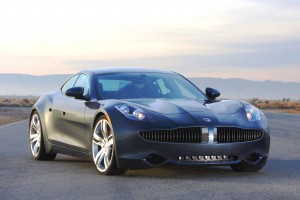
A portion of the new taxpayer loan will help with the launch of the Fisker Karma, but most of the money is aimed at the mainstream plug-in hybrid program, dubbed Project Nina.
The U.S. Department of Energy has approved a $528 million loan for Fisker Automotive that the company said will move it closer to creating affordable, fuel-efficient plug-in hybrid electric cars.
Actually it’s the tax payers who are funding the leveraged company that has yet to deliver a single plug-in hybrid.
The announcement is the latest step in the Obama Administration’s plan to expand the use of battery power with funding going to not only traditional automakers with track records of delivering electric or hybrid cars, such as General Motors, but risky unproven start-ups, such as Fisker and California-based Tesla Motors – as well as to various companies that claim they can deliver advanced battery technology.
“This conditional loan represents a significant step in America’s future,” claimed Henrik Fisker, the eponymous founder and chief executive officer of Fisker Automotive, and one-time chief designer of Aston Martin. “With it Fisker Automotive can rapidly develop affordable clean cars that satisfy our passion for driving and help restore the US as an auto industry leader,” he said.
Some of the low-interest funding will be used to finalize development of the Fisker Karma, a high-styled plug-in electric vehicle for the rich that the company hopes to launch into production next year for a base price of $87,900. Using a set of Lithium-manganese batteries and a pair of electric motors, Karma develops 403 horsepower and a blinding 959 pound-feet of torque. The system is not only quick but is intended to deliver 50 miles of range per charge. When the battery pack discharges, the vehicle switches to a 2.0-liter, direct injection inline-four cylinder engine provided by General Motors to keep it going.
Karma is intended to appeal to the small sub-set of affluent and politically connected and eco-minded buyers that Tesla has targeted with its Roadster, and which Audi hopes to appeal to with its e-tron supercar, due to market in 2013.
The real challenge is moving the company more towards the mainstream, and that’s where the taxpayer subsidized loan could play a critical role, according to Fisker, by enabling the unproven start-up firm to develop “lower cost” models.
A majority of your money will go towards Fisker’s “Project Nina” for the design, engineering and assembly of Fisker’s next-generation of plug-in hybrids, which are expected to sell for about $39,900 after lavish tax credits of at least $7,500.
Fisker Automotive claimed its plug-in hybrid project will create or save at least 5,000 U.S. jobs among auto suppliers and thousands more to manufacture a plug-in hybrid in the U.S.
The money for Fisker is coming from the U.S. Department of Energy’s $25-billion Advanced Technologies Vehicle Manufacturing Loan Program, created by Congress in November 2008 to help promote the development of energy-efficient, advanced-technology vehicles.
Earlier this year, the DOE also approved a similar loan for Tesla, which is selling a pure electric vehicle sports car. That aid is intended to assist the Palo Alto, California-based Tesla to launch its own mainstream entry, a sedan dubbed the Model S, which co-founder Elon Musk promised will reach market “no later than 2012,” in an interview with TheDetroitBureau.com.
